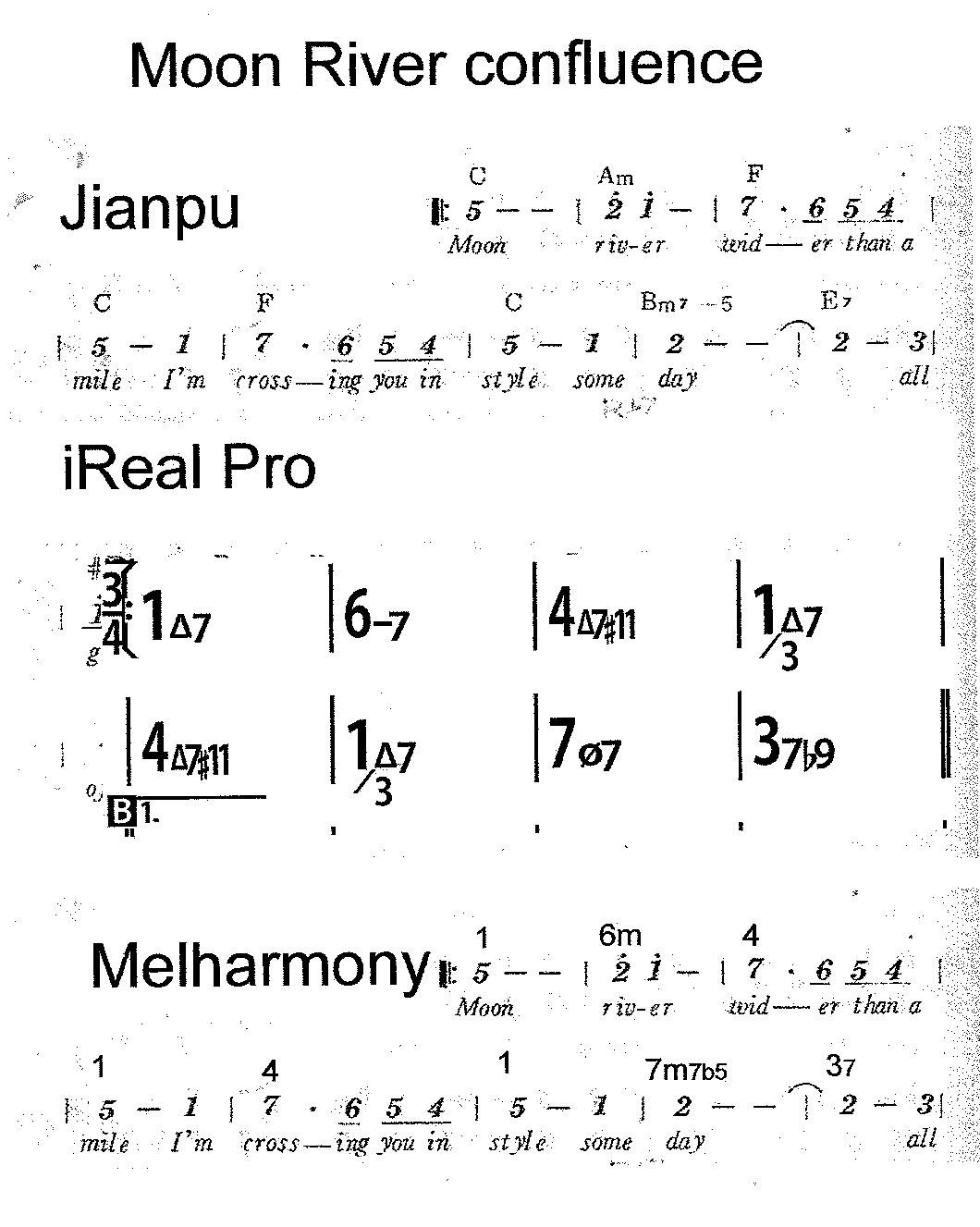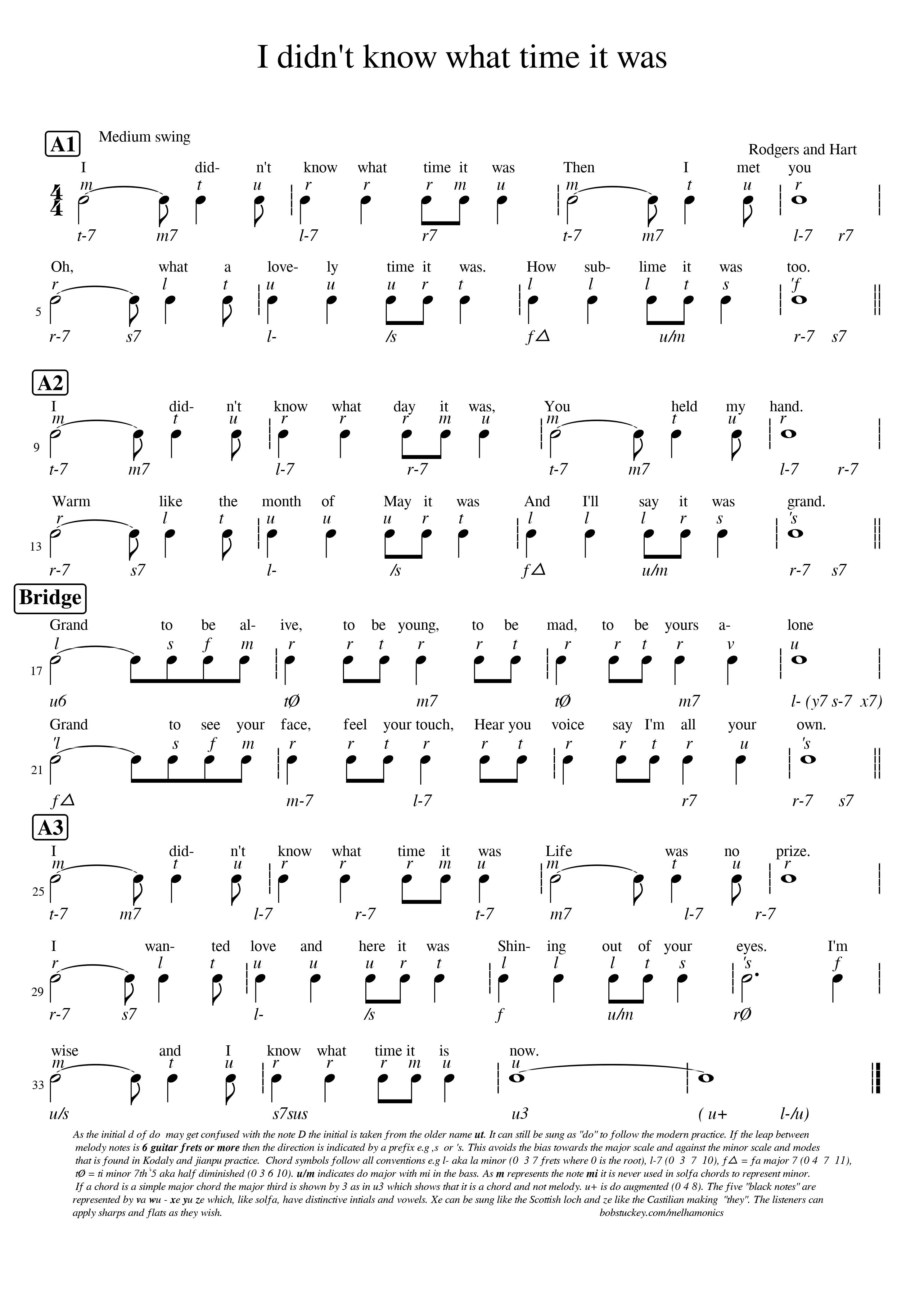the melharmony of popular song
Bob Stuckey


drtec...@gmail.com
RE: "I would like to build up an archive of popular melodies in this format."
Bob,
Seems to me it would be most useful to build up the "archive" in some universal format from which any others could be derived by a simple process or app. Of course, Traditional Notation is such an archive if the translator is human, and is already the most complete. For computer processing, we have no universal standard, but MIDI is close, and MusicXML is in contention. The more popular open notation software formats, such as Lilypond, have a considerable repertoire available, as well as some MNP formats (ExpressStave, Clairnote).
Certainly a "standard" isomorphic "lead sheet" standard would be useful.
From a computer implementation perspective, I would prefer to see something that is "digitally isomorphic" as well.
Understanding that all computer codes are ultimately convertible to binary numbers, by "digitally isomorphic" I mean that the binary number distance between semitones is constant and increasing uniformly as pitch or time (or whatever) increases.
So, for example, the even letters of the Latin alphabet (b d f h j l n p r t v x z) have this property in the standard ASCII/Unicode encodings. I had proposed chromatic syllables based on this sequence, and some rotation among the "singing" vowels U/oo O/oh A/ah E/eh I/ee).
Using the same sequence for chord roots is straightforward. I had not given much thought to encoding the other notes of chords in the most efficient way, but for "stacked thirds" chords, a sequence of two or three binary digits (minor vs. major "third" = 3 vs. 4 semitones) would do.
In principle, as a computer expert, I know how to write a program to convert such a representation into your notation, as well as many others. Whether anyone would choose to do so depends on the utility of the target notation, e.g. to use as a lead sheet for singing or accompanying. I would suspect that a solfa based notation would be more useful to singers than guitarists, but as I don't play the guitar, I'm merely speculating on that.
I would point out, however, that with readily available software, such as Lilypond or Finale, it is now possible to create a traditional "shape note" score or "tab" lead sheet, which gets us most of the way toward what you seem to be seeking.
But thinking about that leads me to suspect that most of the motivation for "improving" TN comes from the an-isomorphic peculiarities of the Pianoforte. I have long ago concluded that reforming notation without reforming the instrument layout itself is not worth the trouble.
Joe Austin aka DrTechDaddy
From: musicn...@googlegroups.com <musicn...@googlegroups.com> On Behalf Of Bob Stuckey
Sent: Thursday, February 24, 2022 4:03 PM
To: musicn...@googlegroups.com
Subject: [MNP] the melharmony of popular song
Hi All
I coined the word melharmony for the description of a song where the melody and harmony use the same terms. For example in a Chinese restaurant where I played the waiters would bring up songs they wanted to sing written in jianpu (movable where 1 = do) but with chord symbols based on ABC. Meanwhile the app iReal Pro used by jazz musicians offers the movable harmony based on 1 = do aka Nashville, but no melody . Could we combine them? The book of tunes in jianpu , a souvenir from the restaurant, has Moon River as does iReal Pro. We could blend the versions to arrive at the melharmony. Although the chords in the jianpu book are simpler than the iReal Pro version the essence is the same.

It interesting that both jianpu and Nashville originally stem from ideas of the French philosopher Rousseau around 1750. But actually I feel solfa can do a better job for several reasons:
-Solfa syllables have beautifully contrasting vowels and consonants which are known internationally whereas the number names sound different from language to language.
-Upper case letters can be used for fixed solfa and lower case for movable. Many of the contributors of MNP are from the US, Canada, UK and Australia. We tend to forget that half the world uses fixed solfa to identify notes ( i.e Do Re Mi..rather than CDE etc ).
-The numbers are strongly biased towards the major scale. What about the minor scale and the modes? The number 1 will always be top dog. In solfa there is slill some bias towards do but it is easier for the other syllables to achieve prominence.
When chromatic solfa syllables are included they can also take centre stage..
Another way in which 1 hangs onto its status is its position as boundary for the octave markers. Notice in the second bar of the jianpu the dots above 2 and 1 which indicate that the melody has crossed an octave zone. The same principle is often used in solfa where Moon River would be written with the suffix as s r' d'.
To eradicate this bias I have used another principle - assume that the melody is moving to the nearest note but if it is moving 6 guitar frets or more show the direction with a prefix . For example mi ti moves down whereas mi 'ti moves up.
To put these ideas into practice I have chosen the jazz standard I didn't know what time it was. The use of traditional rhythmic symbols brings this very close to the Kodaly music education style.
The main difference is that do is here indicated by the initial of its older name Ut so as to avoid any confusion with the letter name D. It is still sung as do as in the modern tradition. The note ti can be sung as tsi thereby incorporating the Si of the fixed solfa tradition.
The second difference is the use of the "black note" names
va wu xe yu ze
which luckily share no initials with other prominent note systems ABCD...AHCD... Do Re Mi ...Sa Re Ga ...
There is a fuller explanation at the foot of the page. If you are tempted to try it out I would suggest you first play the melody with do=C to get used to the interval direction rule. Then play the roots of the chords in the bass (or the bass note to the right of a slash) then combine melody and bass note. Next work out the chord notes and add some to your accompaniment. Then sing it or ask a singer to join you and try it in different keys. There is a pdf version lower down which may be easier to print out.

In an ideal world the user could flick between Nashville and solfa. This version was put together using the free program Musescore. You can download the song file from the site and alter the chords to your liking. It is important to have italics so that l is distinctive: I could not find a way to get Musescore to recognise an italic solfa root, or chords below the stave and lyrics above, it seems, so I had to use various workarounds. There may be other solutions waiting.
I would like to build up an archive of popular melodies in this format. All feedback, comments and contributions welcome.
Bob
--
You received this message because you are subscribed to the forum of the Music Notation Project (hosted by Google Groups).
To post to this group, send email to musicn...@googlegroups.com
To unsubscribe from this group, send email to musicnotatio...@googlegroups.com
For more options, visit this group at http://groups.google.com/group/musicnotation?hl=en
---
You received this message because you are subscribed to the Google Groups "The Music Notation Project | Forum" group.
To unsubscribe from this group and stop receiving emails from it, send an email to musicnotatio...@googlegroups.com.
To view this discussion on the web visit https://groups.google.com/d/msgid/musicnotation/CAGAAJyGt0i%2BQOS0xzgpr%2BtUB4BH_pOCXOKHJ%2B4t5899BKmr_sg%40mail.gmail.com.
J R Freestone
Just one point where I disagree (that I've made enough already, but I'm triggered ;)
"But thinking about that leads me to suspect that most of the motivation for "improving" TN comes from the an-isomorphic peculiarities of the Pianoforte. I have long ago concluded that reforming notation without reforming the instrument layout itself is not worth the trouble."
The piano layout is not at fault, imho. It matches the naming system of the notes, and, although it is perfectly reasonable to advocate getting rid of those in favour of an isomorphic naming system, I take the pragmatic view that that ideal is unlikely ever to materialise. It's tempting to say, "unfortunately" (in fact I did and edited it out!) - but it has pros and cons.
For one thing, there is still enough music that is diatonic for that naming system to have value. Secondly, enough people will probably always want to learn TN (and certainly will for decades) that removing the naming system that links us to it would be unwise. Thirdly, the pattern of black and white notes has an enormous advantage, which is easy to miss unless you're presented with an isomorphic keyboard. If all the trees look the same, in the interests of equality and "logic", how do you find your way around the forest? The octave is beautifully divided up such that we're much less likely to get lost than if the bank of all-white notes just had numbers on them, or consonant letters.
I'm undecided on how valuable a new "digitally isomorphic" data standard would be. Or rather, I think it would probably be great for a certain set of notation types, but not fit others, so wouldn't ever be universal, at least without mashing together significantly different methods of parsing into one nominally "universal" system. Maybe that's fine, but I rather wonder if it's a forced universality for the sake of it. I mean, very dissimilar systems can always be transformed with a program, and a small parser and smaller files are sometimes better than ones that are big and complex enough to be used in virtually any notation.
John
To view this discussion on the web visit https://groups.google.com/d/msgid/musicnotation/013301d82cb4%24f8904710%24e9b0d530%24%40gmail.com.
Bob Stuckey
To view this discussion on the web visit https://groups.google.com/d/msgid/musicnotation/fed5df14-0c3a-18b5-f97d-c8f709e3e3da%40gmail.com.
